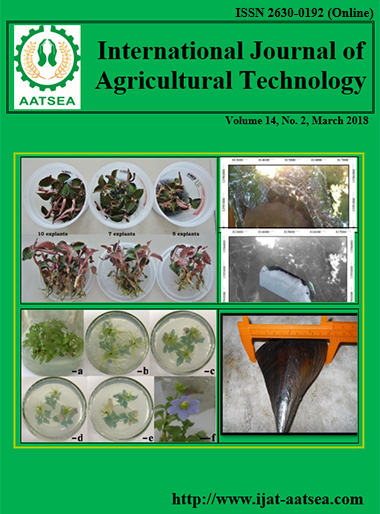Formulation, sensory and pulp stability of durian (Durio zibethinus Murr) juice
Main Article Content
Abstract
Durian (Durio zibethinus Murr) is a popular tropical fruit widely grown in South-East Asia. Due to it is highly nutritious; thus, durian juice was formulated with different concentrations of 20, 25 and 30 % w/w of durain puree, and, with or without the coconut milk. The effects of different concentrations of durian pulp on various parameters (e.g., color, pH, total soluble solids (TSS), viscosity and sensoryevaluation) were investigated. The juice was fourel to be light yellow in color similarly to soy bean milk or to light brown color with depended upon time (min) and temperature (°C) of sterilization. The results indicated that TSS, pH and viscosity of the juice increase varied by the puree concentration. Consumer rated this product to like slightly of 6.03+0.2 from 9- point Hedonic scale. Like many commercially available beverages, durian juice has unstable over a period of time. Therefore, the addition of stabilizing additive; gellan gumin various concentrations of 0, 0.01, 0.015 and 0.02 %w/w to maintain the juice homogeneity at room temperature 27-34 °C was studied. As the result, there was significant increased in viscosity of the juice varied by gellan gum concentration which was found that the minimum concentration of 0.015 %w/w could be used to maintain the juice stability within 28 days.
Article Details

This work is licensed under a Creative Commons Attribution-NonCommercial-NoDerivatives 4.0 International License.
References
Amerine, M. A., Pangborn, R. M. and Roessler, E. B. (1965). Principles of sensory evaluation of food. In: Food Science and Technology Monographs. pp. 338-339.
Anderson, D. M. W., Brydon, W. G. and Eastwood, M. A. (1988). The dietary effects of gellan gum in humans. Food Additives and Contaminants 5:237-249.
Baldry, J., Dougan, J. and Howard, G. E. (1972). Volatile flavoring constituents of durian. Phytochemistry 11:2081-2084.
Bais, K. (2016). Why Thailand is the leading exporter of durian, mangosteen and other tropical fruits. Utar Agriculture Science Journal 2:1-11.
Banerjee, S. and Bhattacharya, S. (2012). Food gels: gelling process. Critical Review InFood Science and Nutrition 52:334-346.
Brownlee, I. A., Havler, M. E., Dettmar, P. W., Allen, A. and Pearson, J. P. (2003). Colonic mucus: secretion and turnover in relation to dietary fiber intake. Proceedings of the Nutrition Society 62:245-249.
Burey, P., Bhandari, B. R., Howes, T. and Gidley, M. (2008). Hydrocolloid gel particles: formation, characterization and application. Critical Review in Food Science and Nutrition 48:361-377.
De Vries, J., Miller, P. E. and Verbeke, K. (2015). Effects of cereal fiber on bowel function: A systematic review of intervention trials. World Journal Gastroenterology 21:8952-8963.
Floribeth, V. and Lastreto, C. (1981). A study of the production of clarified banana juice using Pectinolytic enzymes. Journal of Food Technology 16:115-125.
Ghafoor, K., Jung, J. E. and Choi, Y. H. (2008). Effects of gellan, xanthan, and λ-carrageenan on ellagic acid sedimentation, viscosity, and turbidity of ‘campbell early’ grape juice. Food Scence Biotechnoogy 17:80-84.
Mkrtchyan, G., Aleshin, V., Parkhomenko, Y., Kaehne, T., Di Salvo, M. L., Parroni, A., Contestabile, R., Vovk, A., Bettendorff, L. and Bunik, V. (2015). Molecular mechanisms of the non-coenzyme action of thiamin in brain: biochemical, structural and pathway analysis. Scientific Reports 5, Article number: 12583.
Howe, G. R., Benito, E., Castelleto, R., Cornee, J., Esteve, J., Gallagher, R. P., Iscovich, J. M., Deng-ao, J., Kaaks, R. and Kune, G. A. (1992). Dietary intake of fiber and decreased risk of cancers of the colon and rectum: evidence from the combined analysis of 13 case-control studies. Journal of the National Cancer Institute 84:1887-1896.
Imeson, A. (2010). Food stabilisers, Thickeners and Gelling Agents. New Delhi, India. 343 pp.
Jagtiani, J., Chang, H. T. and Sakai, W. S. (1998). Guava. In: Tropical Fruit Procecssing. New York: Academic Press.
Kregiel, D. (2015). Hindawi Publishing Corporation BioMed Research International Volume 2015, Article ID 128697 15 pp.
Norjana, I. and Noor-Aziah, A. A. (2011). Quality attributes of durian (DuriozibethinusMurr) juiceafterpectinase enzyme treatment. International Food Research Journal 18:1117-1122.
Oakenfull, D. (1987). Gelling agents. Critical Review in Food Science and Nutrition 26:1-25.
O’Neill, M. A., Selvendran, R. R. and Morris, V. J. (1983). Structure of the acidic extracellular gelling polysaccharide produced by Pseudomonas elodea. Carbohydrate Research 124:123-133.
Ristovska, G., Dmitrovska, M. and Najdenkoska, A. (2012). Safety issues associated with nonalcoholic beverages, Food Safety Magazine 6:58-80.
Leon, J. R. and Boak, M. G. (1984). Method for preventing separation in fruit juice-containing products. US4433000A. Retrieved 25 August 2017 from https://www.google.com/patents/US4433000.
Saha, D. and Bhattacharya, S. (2010). Hydrocolloids as thickening and gelling agents infood: a critical review. Journal of Food Science Technology 47:587-597.
Schaechter, J. D. and Wurtman, R. J. (1990). Serotonin release varies with braintryptophan level(PDF). Brain Research 532:203-210.
Serpen, J. Y. (2012). Comparison of sugar content in bottled 100% fruit juice versus extracted juice of fresh fruit. Food and Nutrition Sciences 3:1509-1513.
Shankar, S. and Lanza, E. (1991). Dietary fiber and cancer prevention. Hematology/Oncology Clinics of North America 5:25-41.
Slominski, A., Semak, I., Pisarchik, A., Sweatman, T., Szczesniewski, A. and Wortsman, J. (2002). Conversion of L-tryptophan to serotonin and melatonin in human melanoma cells. FEBS Letters. 511:102-106.
Subhadrabandhu, S. and Ketsa, S. (2001). Durian-king of tropical fruit. Throdon, Wellington, New Zealand: Daphne Brasell Associates.
Tribst, A. A., Sant’Ana Ade, S. and de Massaguer, P. R. (2009). Review: icrobiologicalqualityand safety of fruit juices—past, present and future perspectives. Critical Reviews in Microbiology 35:310-339.
Viquez, F., Laetreto, C. and Cooke, R. D. 1981. A study of the production of clarified banana juice using pectinolytic enzymes. Journal of Food Technology 16:115-125.


